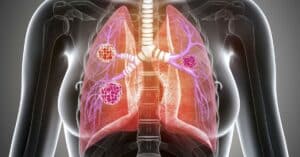Doctors classify lung disease as either obstructive or restrictive.
The term obstructive lung disease includes conditions that hinder a person’s ability to exhale all the air from their lungs.
Those with restrictive lung disease experience difficulty fully expanding their lungs.
Obstructive and restrictive lung disease share one main symptom–shortness of breath with any sort of physical exertion.
Here’s what you need to know about the difference between obstructive and restrictive lung disease.
Obstructive Lung Diseases
Obstructive lung disease and its characteristic narrowing of pulmonary airways hinder a person’s ability to expel air from the lungs completely.
The practical result is that by the end of every breath, quite a bit of air remains in the lungs.
Some common conditions related to obstructive lung disease include:
- Chronic obstructive pulmonary disease (COPD), which encompasses emphysema and chronic bronchitis
- Asthma
- Bronchiectasis
- Cystic Fibrosis
Obstructive lung disease makes breathing significantly harder during increased activity or exertion.
Exhalations take longer with obstructive lung disease so that as the rate of breathing increases and the lungs work harder, the amount of fresh air circulated into the lungs and spent air circulated out decreases.
Restrictive Lung Diseases
People suffering from restrictive lung disease have difficulty fully expanding their lungs when inhaling.
That is, it’s more challenging to fill lungs with air. This is a result of the lungs being restricted from fully expanding.
This can occur when tissue in the chest wall becomes stiffened or due to weakened muscles or damaged nerves. Any of these factors can restrict the expansion of the lungs.
Some of the conditions classified as restrictive lung disease include:
- Interstitial lung disease
- Sarcoidosis
- Neuromuscular diseases, such as amyotrophic lateral sclerosis (ALS)
- Pulmonary fibrosis
- Asbestosis
- Silicosis
The severity of most lung diseases is tested by using a pulmonary function test.
Obstructive and restrictive lung diseases can cause shortness of breath, severe coughing and chest pain.
Treatments are different for each condition and will require a special treatment plan provided by your doctor.
If you have been diagnosed or suspect that you might have lung disease, you should immediately talk to your doctor about your condition.
Do some research on your own to be sure to ask the right questions.
We hope that you have found our article about the difference between obstructive and restrictive lung disease helpful.
While having a chronic lung disease presents many challenges, you can improve your quality of life by gaining more knowledge about your condition, learning about healthy lifestyles, and researching alternative treatments.

Christine Kingsley, APRN is the Health and Wellness Director at the Lung Institute where she focuses on providing helpful online resources for people looking for information on various lung diseases, breathing exercises, and healthy lifestyle choices. She advocates for holistic care that involves working with your doctor to explore all options including traditional and alternative care while focusing on diet and exercise as proactive measures.









